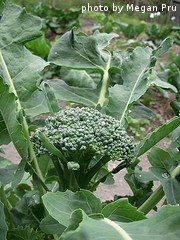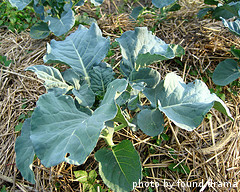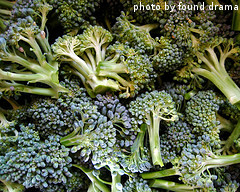Questions About How To Grow Broccoli?
Don't worry - you're in the right spot! If you're looking for answers about how to grow broccoli, we've got you covered. Growing broccoli every year has become a tradition for many backyard vegetable gardeners. Broccoli is an easy vegetable to plant, maintain and harvest. Because it is a cool season crop, it is very common to grow two broccoli crops per year - one in the early spring and another in the fall. It can be grown in both traditional gardens and container gardens.
In our own garden, we typically grow faster maturing broccoli varieties in the spring, because they have a better chance of reaching maturity before the hot summer weather sets in. We grow slower maturing varieties in the fall as the plants will readily tolerate a light frost when the heads are almost ready to harvest.
Like tomatoes and peppers, broccoli does best when seedlings are transplanted into the garden or container. The seeds can be started indoors about a month before the last expected frost in your area. If you don't have much room indoors or find that growing broccoli from seed takes too much time, you can also purchase broccoli seedlings at your local garden center.

Broccoli plants should be planted where they can get 6-8 hours of direct sunlight daily - the more the better. They thrive when daytime temperatures are in the 65-80 degree range, although established plants will tolerate short stretches of warmer or cooler weather. Broccoli plants are thirsty and do well with regular watering. It is very common for folks to plant a crop of broccoli in the early spring and have it harvested and out of the way in time to plant summer vegetables. When some of the summer vegetables die back in the late summer, you can pull them up and plant another crop of broccoli that will be ready for harvest in the fall. This is a great way to maximize garden space and production.
When growing broccoli, think about how much space it will take up in your garden and what plants you might want to grow in its spot during the summer, if so desired. Also consider which varieties might suit your tastes best. Some broccoli varieties are better eaten raw or lightly sauteed, while others are more suited to heavy cooking. Some varieties keep longer than others, and some varieties are better suited for freezing.
We like to plant 3 different varieties in the spring - we choose varieties that mature at around 50, 55 and 60 days. We also spread out our planting times. This way, we get a good, consistent supply of fresh broccoli for several weeks during the spring. In the fall, we typically gorw 1-2 varieties and plant them so they mature all at the same time. This is the broccoli we typically freeze for use during the winter months.

An average broccoli plant will reach about 2 feet tall and 12-18 inches wide, depending on the variety. A typical broccoli plant will produce one large head of broccoli. The size of the head will vary, depending on the variety you are growing. After this main head is harvested, the plant generally produces a couple of smaller heads that off-shoot from the main stem. These too can be harvested and eaten. Once the seedlings have been transplanted, most broccoli varieties are ready to harvest in 50-60 days, although same can take as long as 75 days to reach maturity.
Broccoli seedlings typically transplant well. They grow well with potatoes, radishes, spinach, lettuce, basil, onions, garlic, beets and dill. Because they lend themselves to transplanting well, we grow our broccoli seedlings in flats. However, you can also start the seeds in biodegradable pots that you make yourself using a potmaker and some newspaper. We like to use a mixture of potting soil and composted manure when planting our broccoli seeds.
Once harvested, broccoli can easily be stored in the freezer for several months. It can be eaten raw or boiled, steamed, sauteed, roasted, grilled and even fried. Broccoli is loaded with vitamins, minerals and fiber. And the thick, fibrous stems can be grated up and used in a variety of recipes.
Quick Overview of How To Grow Broccoli
Planting: Start seeds indoors 4 weeks before expected last frost, transplant seedlings into rows, space seedlings 1 foot apart in rows 2 feet apart,
Fertilizing: Apply a balanced fertilizer when transplanting seedlings and again about a month later,
Watering: Need about 1 inch of rain per week, soil should be moist but not wet
Harvesting: Harvest heads when still tightly closed, side shoots can be harvested as they appear
Recipes: Broccoli can be steamed, boiled, sauteed, fried, roasted, grilled or eaten raw
If you are unsure of which broccoli variety to grow, you can ask around at your local farmers' market for information about which varieties perform best in your specific geographic area.
Click on the following links for more information about how to grow broccoli.

Click here to learn about planting broccoli
Click here for information about fertilizing and watering broccoli
Click here to learn about harvesting broccoli
Click here for information about different broccoli varieties
Click here for some of our favorite broccoli recipes
Click here to move from our How To Grow Broccoli page to our Home Page